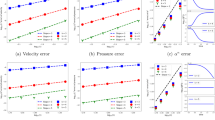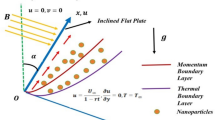Abstract
The behaviour of mixed fluid finite elements, formulated based on the Lagrangian frame of reference, is investigated to understand the effects of locking due to incompressibility and irrotational constraints. For this purpose, both linear and quadratic mixed triangular fluid elements are formulated. It is found that there exists a close relationship between the penalty finite element approach that uses reduced/selective numerical integration to alleviate locking, and the mixed finite element approach. That is, performing reduced/ selective integration in the penalty approach amounts to reducing the order of pressure interpolation in the mixed finite element approach for obtaining similar results. A number of numerical experiments are performed to determine the optimum degree of interpolation of both the mean pressure and the rotational pressure in order that the twin constraints are satisfied exactly. For this purpose, the benchmark solution of the rigid rectangular tank is used. It is found that, irrespective of the degree of mean and the rotational pressure interpolation, the linear triangle mesh, with or without central bubble function (incompatible mode), locks when both the constraints are enforced simultaneously. However, for quadratic triangle, linear interpolation of the mean pressure and constant rotational pressure ensures exact satisfaction of the constraints and the mesh does not lock. Based on the results obtained from the numerical experiments, a number of important conclusions are arrived at.
Similar content being viewed by others
References
Abramson H N 1966 The dynamic behavior of liquids in moving containers. NASA SP–106
Bathe K J 1997Finite element procedures (New Delhi: Prentice Hall of India)
Cook R D, Malkus D S, Plesha M E 1989Concepts and application of finite element analysis (New York: John Wiley & Sons)
Gopalakrishnan S, Devi G 1999a Constraints and mesh locking mechanism in Lagrangian triangular fluid finite elements.Int. J. Comput. Eng. Sci. (submitted)
Gopalakrishnan S, Devi G 1999b A Lagrangian quadratic triangular fluid finite element for fluid-structure interaction problems.Int. J. Comput. Eng. Sci. (submitted)
Hamdi M A, Ousset T, Verchery G 1978 A displacement method for the analysis of vibrations of coupled fluid-structure systems.Int. J. Numer. Methods Eng. 13: 139–150
Hu H C 1955 On some variational principles in the theory of elasticity and the theory of plasticity.Sci. Sin. 4: 33–54
Hughes T G R, Taylor R L, Kanoknukulchal W 1977 A simple and efficient finite element for plate bending.Int. J. Numer. Methods Eng. 11: 1529–1543
Olson G L, Bathe K J 1983 A study of displacement based fluid finite elements for calculating frequencies of the fluid and fluid-structure systems.Nucl. Eng. Des. 76: 137–151
Pian T H H, Lee S W 1976 Notes on finite elements for nearly incompressible materials.AIAA J. 14: 824–826
Prathap G 1993The finite element method in structural mechanics (Dordrecht: Kluwer Academic Press)
Prathap G 1999A priori error estimation of finite element models from first principles.Sādhanā 24: 199–214
Prathap G, Bhashyam G R 1982 Reduced integration and the shear-flexible beam element.Int. J. Numer. Methods Eng. 18: 211–243
Prathap G, Ramesh Babu C 1986a Field consistent strain interpolation for quadratic shear flexible beam element.Int. J. Numer. Methods Eng. 23: 1973–1984
Prathap G, Ramesh Babu C 1986b An isoparametric quadratic thick curved beam element.Int. J. Numer. Methods Eng. 23: 1583–1600
Satish Chandra, Prathap G 1989 A field consistent formulation for the eight noded solid finite element.Comput. Struct. 33: 345–355
Wilson E L, Khalvati M 1983 Finite elements for dynamic analysis of fluid-solid systems.Int. J. Numer. Methods Eng. 19: 1657–1668
Zienkiewicz O C, Taylor R L 1991The finite element method (New York: McGraw Hill) vol. 2
Author information
Authors and Affiliations
Corresponding author
Rights and permissions
About this article
Cite this article
Gopalakrishnan, S., Devi, G. Behaviour of Lagrangian triangular mixed fluid finite elements. Sadhana 25, 21–35 (2000). https://doi.org/10.1007/BF02703804
Received:
Revised:
Issue Date:
DOI: https://doi.org/10.1007/BF02703804




